Citroen C4 RHD 2012 2.G Owner's Manual
Manufacturer: CITROEN, Model Year: 2012, Model line: C4 RHD, Model: Citroen C4 RHD 2012 2.GPages: 324, PDF Size: 28.17 MB
Page 161 of 324

9
DRIVING
159
Deactivation
Going into engine START mode
At any time, press the "ECO OFF"
switch to deactivate the system.
This is confi rmed by the switch warning
lamp coming on accompanied by the
display of a message.
Special cases: START invoked
automatically
If the system has been deacti-
vated in STOP mode, the engine
restarts immediately. The "ECO"
warning lamp goes
off and the engine starts auto-
matically:
- with a manual gearbox
, when you
fully
depress the clutch pedal,
- with the 6-speed electronic gear-
box system
:
●
gear lever in position A
or M
, when
you release the brake pedal,
●
or gear lever in position N
and the
brake pedal released, when you
move the gear lever to position A
or M
,
●
or when you engage reverse gear.
For safety reasons or to ensure smooth
operation, START mode is invoked au-
tomatically when:
- you open the driver's door,
- you unfasten the driver's seat belt,
- the speed of the vehicle exceeds
15 mph (25 km/h) with a manual
gearbox or 7 mph (11 km/h) with the
6-speed electronic gearbox system,
- the electric parking brake is being
applied,
- some special conditions (battery
charge, engine temperature, brak-
ing assistance, ambient tempera-
ture...) where the engine is needed
to assure control of a system.
In this case the "ECO"
warning
lamp fl ashes for few seconds,
then goes off.
With a manual gearbox in STOP
mode, if a gear is engaged with-
out fully depressing the clutch
pedal, a warning lamp comes
on or an alert message is dis-
played asking you to depress
the clutch pedal to restart the
engine.
Reactivation
Press the "ECO OFF"
switch again.
The system is active again; this is con-
fi rmed by the switch warning lamp going
off and the display of a message.
The system is reactivated auto-
matically at every new start using
the key.
This operation is perfectly normal.
Page 162 of 324
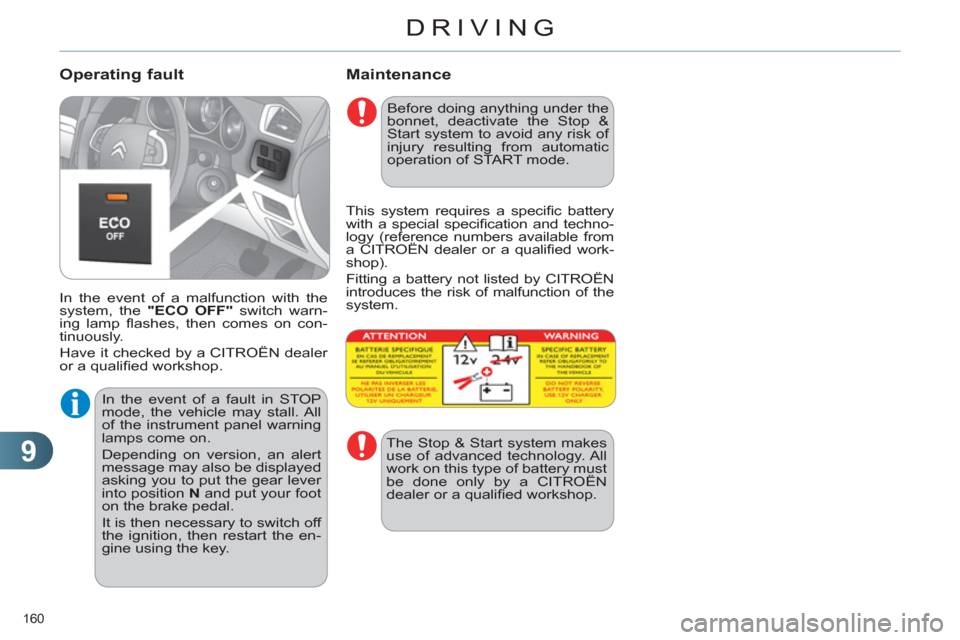
9
DRIVING
160
Maintenance
In the event of a malfunction with the
system, the "ECO OFF"
switch warn-
ing lamp fl ashes, then comes on con-
tinuously.
Have it checked by a CITROËN dealer
or a qualifi ed workshop.
Operating fault
Before doing anything under the
bonnet, deactivate the Stop &
Start system to avoid any risk of
injury resulting from automatic
operation of START mode.
This system requires a specifi c battery
with a special specifi cation and techno-
logy (reference numbers available from
a CITROËN dealer or a qualifi ed work-
shop).
Fitting a battery not listed by CITROËN
introduces the risk of malfunction of the
system.
The Stop & Start system makes
use of advanced technology. All
work on this type of battery must
be done only by a CITROËN
dealer or a qualifi ed workshop.
In the event of a fault in STOP
mode, the vehicle may stall. All
of the instrument panel warning
lamps come on.
Depending on version, an alert
message may also be displayed
asking you to put the gear lever
into position N
and put your foot
on the brake pedal.
It is then necessary to switch off
the ignition, then restart the en-
gine using the key.
Page 163 of 324
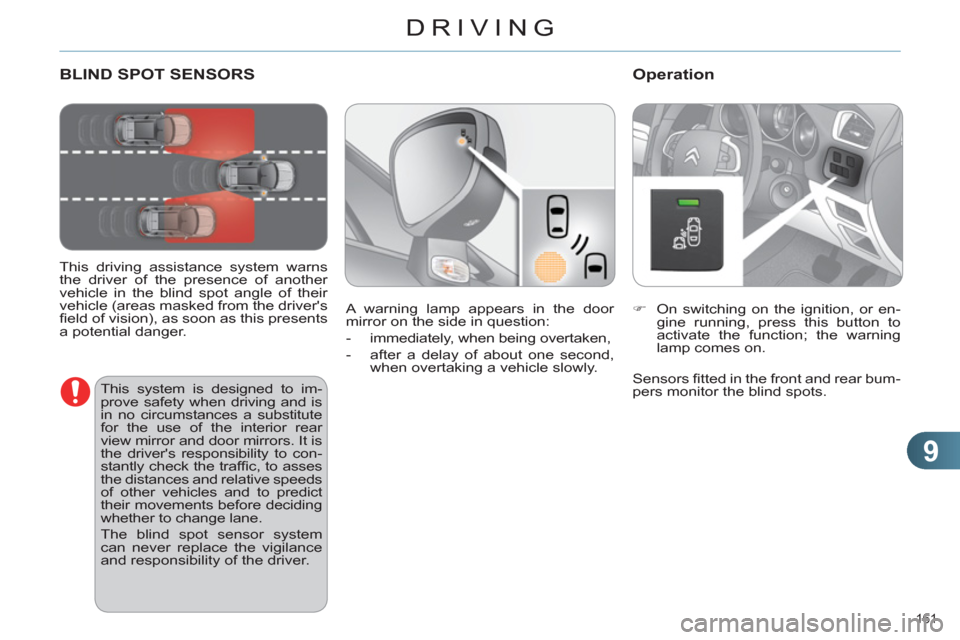
9
DRIVING
161
BLIND SPOT SENSORS
This driving assistance system warns
the driver of the presence of another
vehicle in the blind spot angle of their
vehicle (areas masked from the driver's
fi eld of vision), as soon as this presents
a potential danger.
Operation
�)
On switching on the ignition, or en-
gine running, press this button to
activate the function; the warning
lamp comes on.
This system is designed to im-
prove safety when driving and is
in no circumstances a substitute
for the use of the interior rear
view mirror and door mirrors. It is
the driver's responsibility to con-
stantly check the traffi c, to asses
the distances and relative speeds
of other vehicles and to predict
their movements before deciding
whether to change lane.
The blind spot sensor system
can never replace the vigilance
and responsibility of the driver.
Sensors fi tted in the front and rear bum-
pers monitor the blind spots. A warning lamp appears in the door
mirror on the side in question:
- immediately, when being overtaken,
- after a delay of about one second,
when overtaking a vehicle slowly.
Page 164 of 324
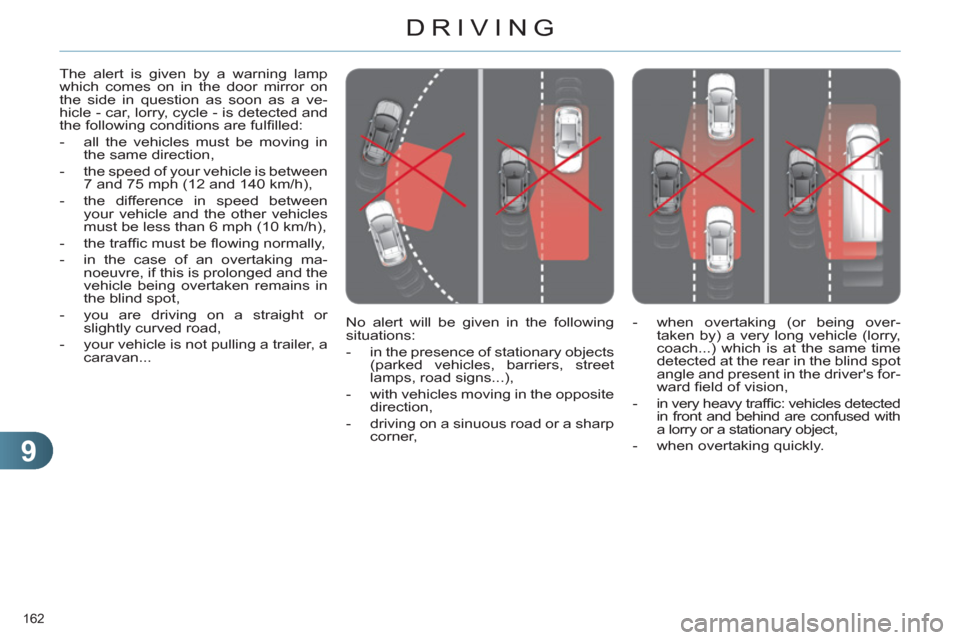
9
DRIVING
162
No alert will be given in the following
situations:
- in the presence of stationary objects
(parked vehicles, barriers, street
lamps, road signs...),
- with vehicles moving in the opposite
direction,
- driving on a sinuous road or a sharp
corner, The alert is given by a warning lamp
which comes on in the door mirror on
the side in question as soon as a ve-
hicle - car, lorry, cycle - is detected and
the following conditions are fulfi lled:
- all the vehicles must be moving in
the same direction,
- the speed of your vehicle is between
7 and 75 mph (12 and 140 km/h),
- the difference in speed between
your vehicle and the other vehicles
must be less than 6 mph (10 km/h),
- the traffi c must be fl owing normally,
- in the case of an overtaking ma-
noeuvre, if this is prolonged and the
vehicle being overtaken remains in
the blind spot,
- you are driving on a straight or
slightly curved road,
- your vehicle is not pulling a trailer, a
caravan...
- when overtaking (or being over-
taken by) a very long vehicle (lorry,
coach...) which is at the same time
detected at the rear in the blind spot
angle and present in the driver's for-
ward fi eld of vision,
- in very heavy traffi c: vehicles detected
in front and behind are confused with
a lorry or a stationary object,
- when overtaking quickly.
Page 165 of 324
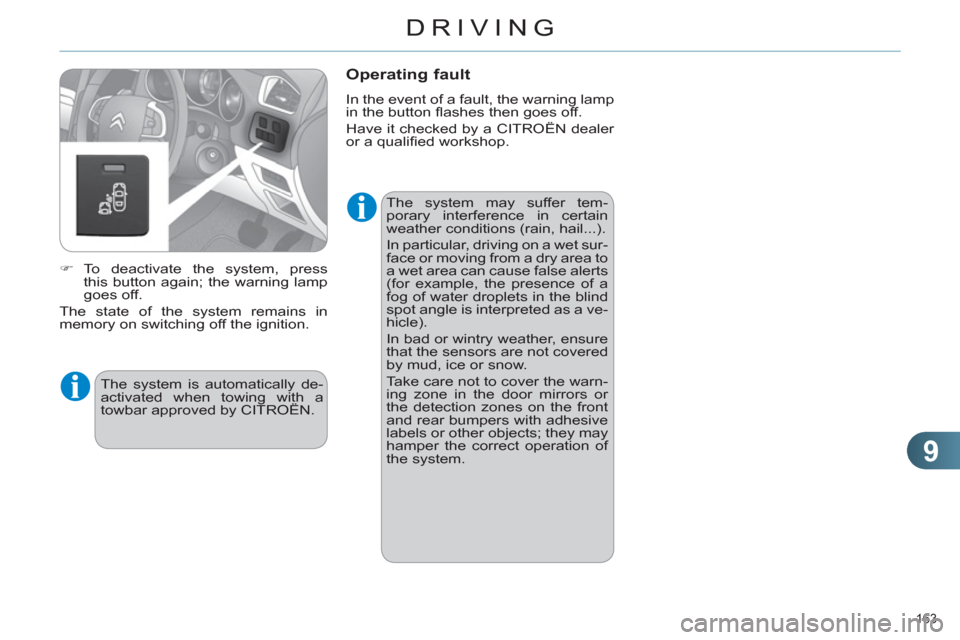
9
DRIVING
163
The system may suffer tem-
porary interference in certain
weather conditions (rain, hail...).
In particular, driving on a wet sur-
face or moving from a dry area to
a wet area can cause false alerts
(for example, the presence of a
fog of water droplets in the blind
spot angle is interpreted as a ve-
hicle).
In bad or wintry weather, ensure
that the sensors are not covered
by mud, ice or snow.
Take care not to cover the warn-
ing zone in the door mirrors or
the detection zones on the front
and rear bumpers with adhesive
labels or other objects; they may
hamper the correct operation of
the system.
�)
To deactivate the system, press
this button again; the warning lamp
goes off.
The state of the system remains in
memory on switching off the ignition.
Operating fault
In the event of a fault, the warning lamp
in the button fl ashes then goes off.
Have it checked by a CITROËN dealer
or a qualifi ed workshop.
The system is automatically de-
activated when towing with a
towbar approved by CITROËN.
Page 166 of 324
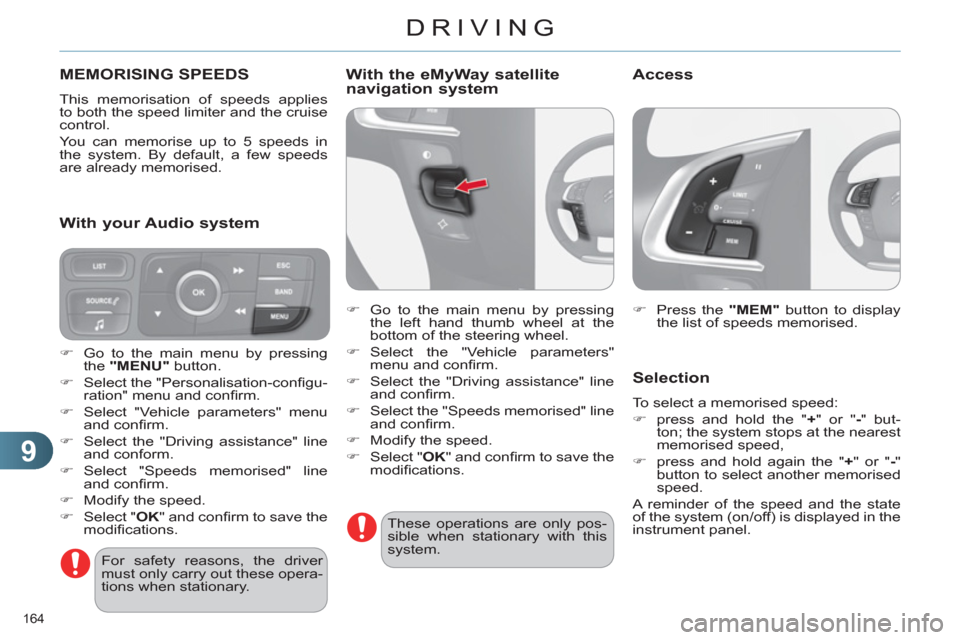
9
DRIVING
164
MEMORISING SPEEDS
This memorisation of speeds applies
to both the speed limiter and the cruise
control.
You can memorise up to 5 speeds in
the system. By default, a few speeds
are already memorised.
�)
Press the "MEM"
button to display
the list of speeds memorised.
Selection
To select a memorised speed:
�)
press and hold the " +
" or " -
" but-
ton; the system stops at the nearest
memorised speed,
�)
press and hold again the " +
" or " -
"
button to select another memorised
speed.
A reminder of the speed and the state
of the system (on/off) is displayed in the
instrument panel.
For safety reasons, the driver
must only carry out these opera-
tions when stationary.
�)
Go to the main menu by pressing
the "MENU"
button.
�)
Select the "Personalisation-confi gu-
ration" menu and confi rm.
�)
Select "Vehicle parameters" menu
and confi rm.
�)
Select the "Driving assistance" line
and conform.
�)
Select "Speeds memorised" line
and confi rm.
�)
Modify the speed.
�)
Select " OK
" and confi rm to save the
modifi cations.
With your Audio system
With the eMyWay satellite
navigation system
�)
Go to the main menu by pressing
the left hand thumb wheel at the
bottom of the steering wheel.
�)
Select the "Vehicle parameters"
menu and confi rm.
�)
Select the "Driving assistance" line
and confi rm.
�)
Select the "Speeds memorised" line
and confi rm.
�)
Modify the speed.
�)
Select " OK
" and confi rm to save the
modifi cations.
These operations are only pos-
sible when stationary with this
system.
Access
Page 167 of 324
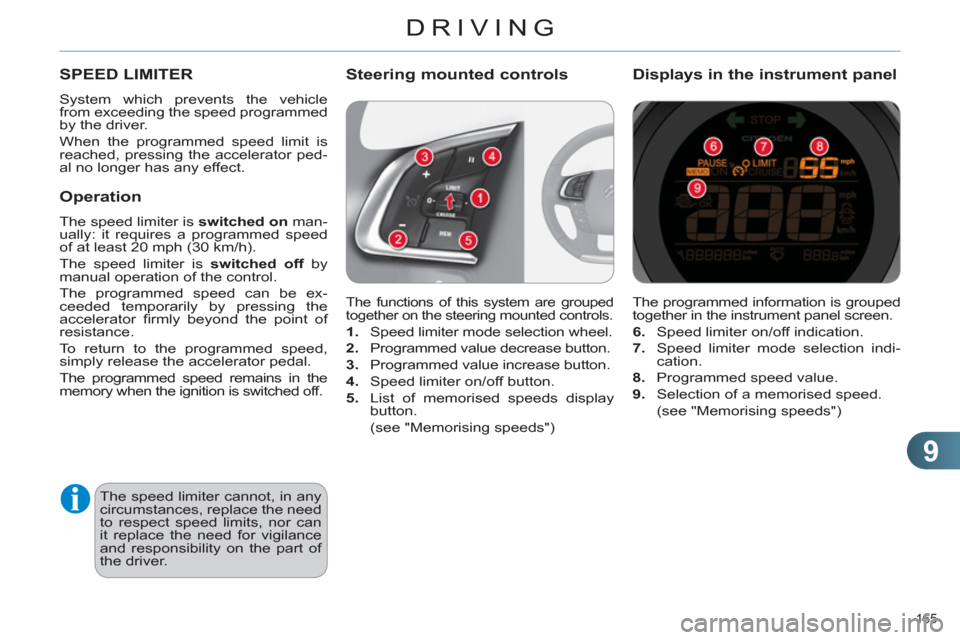
9
DRIVING
165
The programmed information is grouped
together in the instrument panel screen.
6.
Speed limiter on/off indication.
7.
Speed limiter mode selection indi-
cation.
8.
Programmed speed value.
9.
Selection of a memorised speed.
(see "Memorising speeds")
Displays in the instrument panel
SPEED LIMITER
System which prevents the vehicle
from exceeding the speed programmed
by the driver.
When the programmed speed limit is
reached, pressing the accelerator ped-
al no longer has any effect.
The speed limiter cannot, in any
circumstances, replace the need
to respect speed limits, nor can
it replace the need for vigilance
and responsibility on the part of
the driver.
The functions of this system are grouped
together on the steering mounted controls.
1.
Speed limiter mode selection wheel.
2.
Programmed value decrease button.
3.
Programmed value increase button.
4.
Speed limiter on/off button.
5.
List of memorised speeds display
button.
(see "Memorising speeds")
Steering mounted controls
Operation
The speed limiter is switched on
man-
ually: it requires a programmed speed
of at least 20 mph (30 km/h).
The speed limiter is switched off
by
manual operation of the control.
The programmed speed can be ex-
ceeded temporarily by pressing the
accelerator fi rmly beyond the point of
resistance.
To return to the programmed speed,
simply release the accelerator pedal.
The programmed speed remains in the
memory when the ignition is switched off.
Page 168 of 324
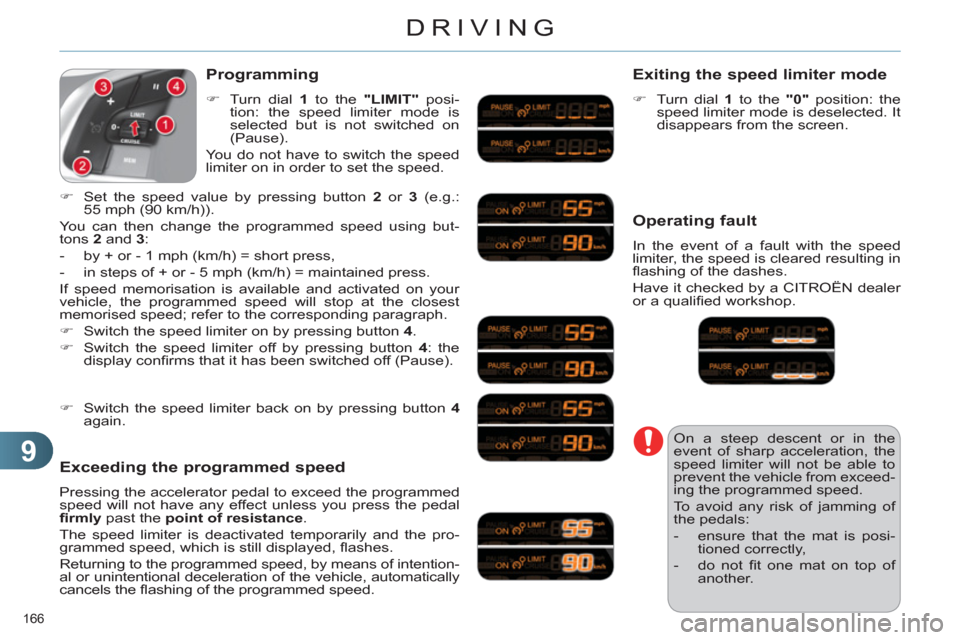
9
DRIVING
166
Programming
�)
Turn dial 1
to the "LIMIT"
posi-
tion: the speed limiter mode is
selected but is not switched on
(Pause).
You do not have to switch the speed
limiter on in order to set the speed.
�)
Set the speed value by pressing button 2
or 3
(e.g.:
55 mph (90 km/h)).
You can then change the programmed speed using but-
tons 2
and 3
:
- by + or - 1 mph (km/h) = short press,
- in steps of + or - 5 mph (km/h) = maintained press.
If speed memorisation is available and activated on your
vehicle, the programmed speed will stop at the closest
memorised speed; refer to the corresponding paragraph.
�)
Switch the speed limiter on by pressing button 4
.
�)
Switch the speed limiter off by pressing button 4
: the
display confi rms that it has been switched off (Pause).
Exceeding the programmed speed
Pressing the accelerator pedal to exceed the programmed
speed will not have any effect unless you press the pedal
fi rmly
past the point of resistance
.
The speed limiter is deactivated temporarily and the pro-
grammed speed, which is still displayed, fl ashes.
Returning to the programmed speed, by means of intention-
al or unintentional deceleration of the vehicle, automatically
cancels the fl ashing of the programmed speed.
Exiting the speed limiter mode
�)
Turn dial 1
to the "0"
position: the
speed limiter mode is deselected. It
disappears from the screen.
Operating fault
In the event of a fault with the speed
limiter, the speed is cleared resulting in
fl ashing of the dashes.
Have it checked by a CITROËN dealer
or a qualifi ed workshop.
On a steep descent or in the
event of sharp acceleration, the
speed limiter will not be able to
prevent the vehicle from exceed-
ing the programmed speed.
To avoid any risk of jamming of
the pedals:
- ensure that the mat is posi-
tioned correctly,
- do not fi t one mat on top of
another.
�)
Switch the speed limiter back on by pressing button 4
again.
Page 169 of 324
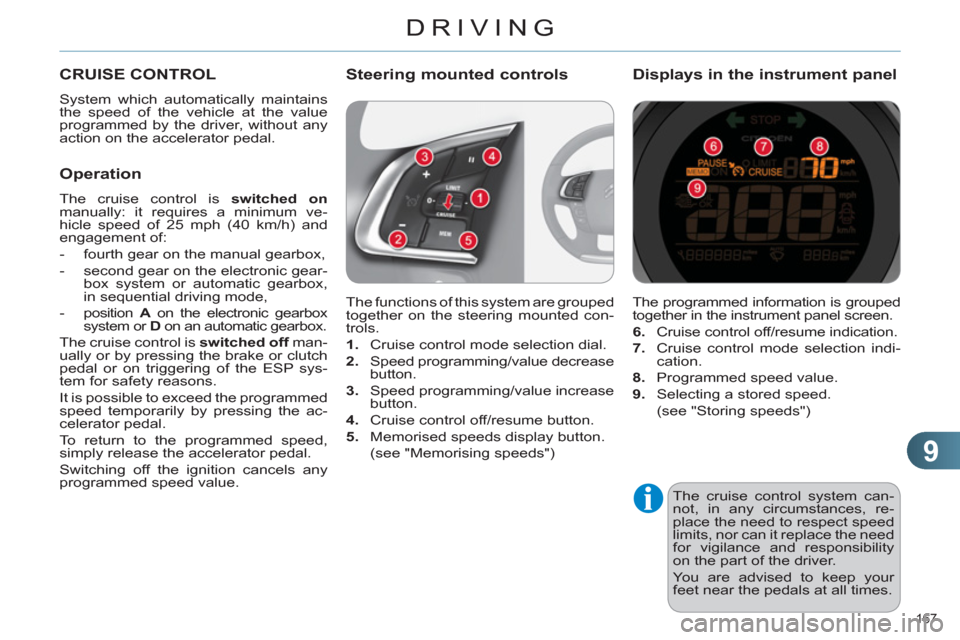
9
DRIVING
167
The cruise control system can-
not, in any circumstances, re-
place the need to respect speed
limits, nor can it replace the need
for vigilance and responsibility
on the part of the driver.
You are advised to keep your
feet near the pedals at all times.
CRUISE CONTROL
System which automatically maintains
the speed of the vehicle at the value
programmed by the driver, without any
action on the accelerator pedal.
The functions of this system are grouped
together on the steering mounted con-
trols.
1.
Cruise control mode selection dial.
2.
Speed programming/value decrease
button.
3.
Speed programming/value increase
button.
4.
Cruise control off/resume button.
5.
Memorised speeds display button.
(see "Memorising speeds")
Steering mounted controls
The programmed information is grouped
together in the instrument panel screen.
6.
Cruise control off/resume indication.
7.
Cruise control mode selection indi-
cation.
8.
Programmed speed value.
9.
Selecting a stored speed.
(see "Storing speeds")
Displays in the instrument panel
Operation
The cruise control is switched on
manually: it requires a minimum ve-
hicle speed of 25 mph (40 km/h) and
engagement of:
- fourth gear on the manual gearbox,
- second gear on the electronic gear-
box system or automatic gearbox,
in sequential driving mode,
-
position A
on the electronic gearbox
system or D
on an automatic gearbox.
The cruise control is switched off
man-
ually or by pressing the brake or clutch
pedal or on triggering of the ESP sys-
tem for safety reasons.
It is possible to exceed the programmed
speed temporarily by pressing the ac-
celerator pedal.
To return to the programmed speed,
simply release the accelerator pedal.
Switching off the ignition cancels any
programmed speed value.
Page 170 of 324
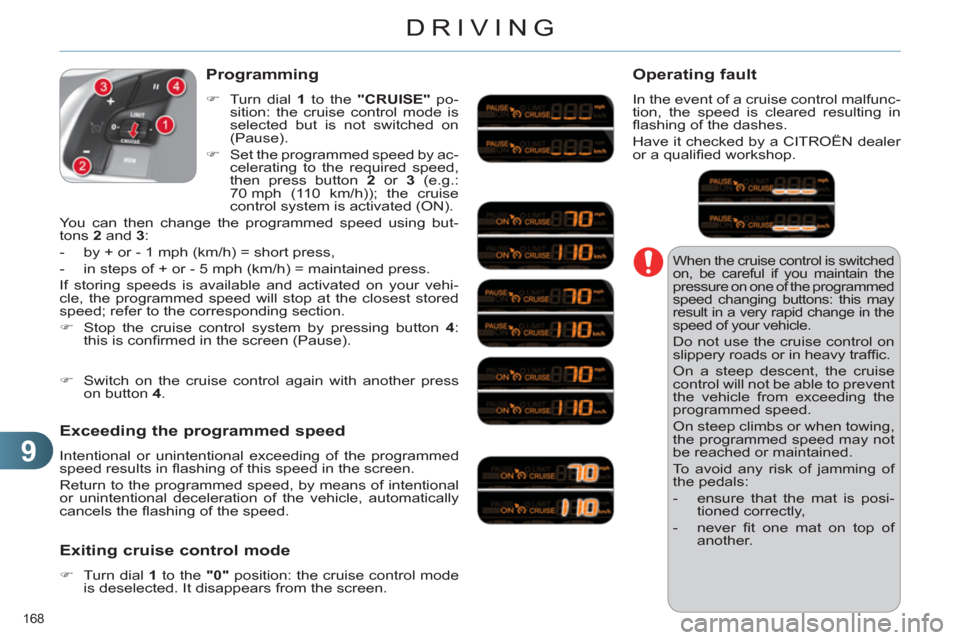
9
DRIVING
168
When the cruise control is switched
on, be careful if you maintain the
pressure on one of the programmed
speed changing buttons: this may
result in a very rapid change in the
speed of your vehicle.
Do not use the cruise control on
slippery roads or in heavy traffi c.
On a steep descent, the cruise
control will not be able to prevent
the vehicle from exceeding the
programmed speed.
On steep climbs or when towing,
the programmed speed may not
be reached or maintained.
To avoid any risk of jamming of
the pedals:
- ensure that the mat is posi-
tioned correctly,
- never fi t one mat on top of
another.
Programming
�)
Turn dial 1
to the "CRUISE"
po-
sition: the cruise control mode is
selected but is not switched on
(Pause).
�)
Set the programmed speed by ac-
celerating to the required speed,
then press button 2
or 3
(e.g.:
70 mph (110 km/h)); the cruise
control system is activated (ON).
You can then change the programmed speed using but-
tons 2
and 3
:
- by + or - 1 mph (km/h) = short press,
- in steps of + or - 5 mph (km/h) = maintained press.
If storing speeds is available and activated on your vehi-
cle, the programmed speed will stop at the closest stored
speed; refer to the corresponding section.
�)
Stop the cruise control system by pressing button 4
:
this is confi rmed in the screen (Pause).
Exceeding the programmed speed
Intentional or unintentional exceeding of the programmed
speed results in fl ashing of this speed in the screen.
Return to the programmed speed, by means of intentional
or unintentional deceleration of the vehicle, automatically
cancels the fl ashing of the speed.
Exiting cruise control mode
�)
Turn dial 1
to the "0"
position: the cruise control mode
is deselected. It disappears from the screen.
�)
Switch on the cruise control again with another press
on button 4
.
Operating fault
In the event of a cruise control malfunc-
tion, the speed is cleared resulting in
fl ashing of the dashes.
Have it checked by a CITROËN dealer
or a qualifi ed workshop.